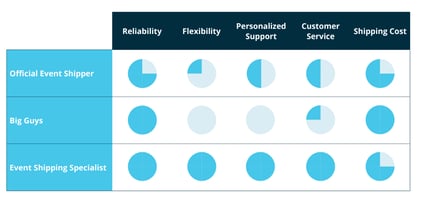You’ve done the planning for this event. You have your timeline set, your sales and exhibition...
Ultimate 2019 Trade Show and Event Planning Checklist

(not that kind of list)
Planning tradeshows involves coordinating a lot of moving parts. Whether your prefer slick technological solutions or the old school pen-and-paper approach, there’s only one way to make sure all your bases are covered leading up to an event: make a checklist.
A tradeshow planning checklist will help you keep track of all the information you need when you’re getting ready for an event: general information about the event itself, accommodation info, details on event logistics and vendors, and your own company’s materials requirements.
To create your ultimate planning checklist, all you need is the information below and a place to keep it. I’ve seen tradeshow managers use online tools like Evernote, OneNote, and Notion, and I’ve seen others get the same results with a three-ring binder and a pen. The physical form it takes is far less important than the logical process it enables.
Step One – General Information
First, let’s look at the basic information you’ll need to collect about each event. Some of this you’ll know before you even start completing your checklist, but it’s a good idea to document everything (even the obvious stuff like the event name) in the same place. Over time, you’ll find yourself using previous events’ checklists as a reference, and that’s a lot easier to do if you record all the details together.
-
Event Name
-
Dates
-
Address
-
Directions
-
Target Move-In Date and Time
-
Loading Zone/Dock Location and Info
-
Target Move-Out Date and Time
-
Sponsoring Organization
-
Contact
-
Phone, Fax, Email, Cell
-
Show Management Main Contact
-
Phone, Fax, Email, Cell
-
A List of Show Contractors
-
Phone, Fax, Email, Cell for Each Contractor
Step Two – Accommodations
Making sure you have your personal needs in order will take a lot of stress out of your tradeshow experience and allow you to focus your attention on the event itself.
Keep this information in more than one location, like a smart phone, note card, and on your computer. That way, if you get lost or separated from your group, you can simply tell a cab driver where to take you and avoid getting caught up in something out of a Cheech and Chong movie.
-
Hotel
-
Address, Directions
-
Phone, Fax, Website
-
Main Contact
-
Phone, Fax, Cell, Email
-
Number and Type of Rooms Needed for Staff
-
Check-In Date, Check-Out Date
Step Three – Event Logistics
These are the items or services you’re getting from third party vendors. For each item on the list, make a note of the vendor’s name and contact information, along with the date they were ordered or confirmed and by whom.
-
Number and Type of Rooms Needed for Event Logistics
-
Exhibit Literature Printing and Delivery
-
Contacts
-
Delivery Dates and Times
-
Tracking Numbers
-
Premiums (giveaways)
-
Shipping
-
AV, Computers, Graphics, Lighting, Electrical, Photography
-
Telecom
-
Transportation
-
Entertaining
-
I&D (Install & Dismantling of booth at show site)
-
Carpet/Padding
-
Cleaning
-
Floral
-
Trash collection
-
Security
-
Clothing
-
Training
-
Product
Step Four – Event Requirements
Last, but certainly not least, are the items you need to have onsite for a successful event. This list will be similar, but not identical, to your shipping inventory. In fact, it’s a good idea to cross-check the two and ensure that everything on your requirements checklist appears somewhere in your shipping inventory before your shipment departs.Exhibit booth (All pieces that make up the exhibit booth- lighting, backdrop, panels, cables, graphics)
-
Exhibit Literature
-
Premiums (giveaways)
-
Clothing (Team attire)
-
Shipping
-
Inbound Shipping Info (see our First Timer’s Guide)
-
Outbound Shipping Info (see our First Timer’s Guide)
-
AV, Computers, Graphics, Lighting, Electrical
-
Staff
-
Transportation
-
Entertaining
-
I&D (Install & Dismantling of booth at show site)
-
Carpet/Padding
-
Photography
-
Floral
-
Clothing
-
Product
One final note: having all of your contact information and show requirements in an orderly list does you little good if you don’t communicate effectively with your partners and vendors. The more parties are involved, like your exhibit house, printer, and shipper, the more complex your communication needs become. Set a standard and a communication routine for all parties involved to ensure that no one’s dealing with last-minute surprises.
For more tradeshow tips and tools, check out The First-Timer’s Guide to Tradeshow Shipping and our downloadable checklist.
Photo Credit: Kevin Dooley, flickr

